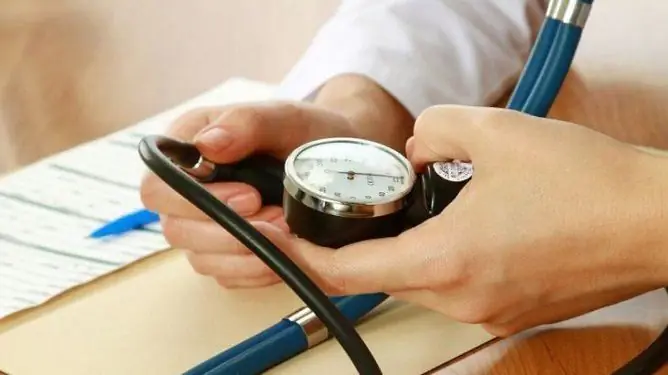- Author Rachel Wainwright [email protected].
- Public 2023-12-15 07:39.
- Last modified 2025-11-02 20:14.
Angiopathy
The content of the article:
- Causes and risk factors
- Forms of angiopathy
- Symptoms
- Diagnostics
- Treatment
- Possible complications and consequences
- Forecast
- Prevention
Angiopathy is a pathology of blood vessels that develops as a result of impaired nervous regulation. A decrease in the tone of blood vessels leads to disruption of their functioning, as well as a change in the structure of the vascular walls. The pathological process can be localized in different parts of the body or be generalized, it can affect blood vessels of various sizes. The progression of angiopathy leads to the development of irreversible changes in the body due to impaired blood circulation.
Synonym is vasopathy.

Angiopathy - damage to blood vessels due to a disorder of nervous regulation
Causes and risk factors
At the heart of the pathological process in the vessels is a disorder of neuroregulation, leading to a violation of vascular tone, paresis and spasms of micro- and sometimes macrovascular. There can be many reasons for the development of neuroregulatory disorders.
The main risk factors for all forms of angiopathy:
- congenital features of the walls of blood vessels;
- diseases of the hematopoietic system;
- metabolic disorders;
- intoxication;
- traumatic injury;
- overweight;
- elderly age;
- the presence of bad habits;
- passive lifestyle.
The development of angiopathy in patients with diabetes mellitus is a natural process that leads to the progression of the disease. Diabetic angiopathy occurs against the background of inadequate treatment of diabetes mellitus, it is facilitated by uncompensated metabolic disorders, deterioration of oxygen supply to tissues, as well as hormonal changes that aggravate metabolic disorders and contribute to the development of pathological processes in the vascular wall.

Angiopathy is common in diabetic patients
The risk factors for the development of angiopathy of the lower extremities, in addition to diabetes mellitus, include:
- pathological processes in the brain, spinal cord, as well as in peripheral nerves, leading to a violation of the innervation of the vessels;
- damage to the vessels of the microvasculature of the legs in autoimmune diseases;
- arterial hypo- and hypertension with the development of hyalinosis of the vessel walls;
- hypothermia of the lower extremities;
- industrial hazards (in particular, exposure to the body of toxic substances, vibration disease).
Retinal angiopathy develops against the background of osteochondrosis of the cervical spine, increased intracranial pressure, presbyopia of the eyes (impaired focus of vision on closely spaced objects, which is associated with natural age-related changes).
Hypertensive angiopathy occurs against the background of severe hypertension, as well as a genetic predisposition to this pathology.
Forms of angiopathy
Depending on the pathological process that led to the development of pathology, the following forms of angiopathy are distinguished:
- diabetic;
- hypertensive;
- hypotonic;
- cerebral amyloid;
- traumatic retinal angiopathy (traumatic retinopathy);
- juvenile retinal angiopathy (juvenile angiopathy, Eales disease).

Hypertensive retinal angiopathy
Depending on the size of the affected vessels, microangiopathy (damage to small blood vessels) and macroangiopathy (damage to large blood vessels) are distinguished.
Depending on localization:
- angiopathy of the lower and / or upper extremities;
- retinal angiopathy;
- angiopathy of the vessels of the brain (cerebral);
- arterial angiopathy; and etc.
Symptoms
The clinical picture depends on the form, severity of the pathological process and its localization.
Signs of angiopathy of the lower extremities:
- cold skin;
- pallor or cyanotic skin tone;
- the occurrence of hematomas and altered capillaries for no apparent reason;
- the appearance of areas with altered pigmentation, peeling;
- poor healing of even superficial injuries, despite the ongoing treatment;
- numbness, itching, burning and creeping sensation in the lower limbs;
- decreased sensitivity of the legs;
- weakening of the pulsation of the arteries;
- pain in the lower extremities, which manifests itself while walking, intermittent claudication.
Angiopathy of the lower extremities, developed against the background of diabetes mellitus, is characterized by early addition of signs of disorders of the nervous system, which are associated with lesions of small-caliber blood vessels, a combination with lesions of the eyes and kidneys, as well as the formation of trophic ulcers (in severe cases and gangrene) of the lower extremities against the background preserved pulsation of peripheral arteries. The infectious process can develop against the background of minor injuries, cracks in the skin. On the lower extremities (most often on the feet), small, almost painless ulcers appear, which gradually spread to the muscles and bones. With the progression of the pathological process, necrosis occurs, which gradually spreads beyond the ulcers throughout the foot, the so-called diabetic foot develops.
Hypertensive retinal angiopathy in the early stages is asymptomatic or has mild symptoms. Patients experience a slight decrease in visual acuity, the appearance of glare, flashes, lines and / or dots before the eyes.
With the progression of hypertensive angiopathy, the following are noted:
- frequent bleeding in the eye;
- expansion of the veins of the fundus;
- a significant decrease in visual acuity (up to blindness);
- narrowing of the visual fields;
- regular headaches;
- frequent nosebleeds;
- hemoptysis;
- detection of blood impurities in urine, feces;
- increased irritability, emotional instability, anxiety;
- disorders of attention and memory;
- weather dependence.
Vascular changes are reversible when blood pressure is normalized.

Frequent bleeding in the eye is a symptom of angiopathy
Angiopathy of the cerebral vessels is manifested, first of all, by persistent headaches, possibly a violation of orientation in space, hallucinations.
With arterial angiopathy, cardiac disturbances, thrombus formation are observed.
Diagnostics
The use of certain diagnostic methods depends on the form of angiopathy. Most often, they resort to contrast x-ray examination of blood vessels (angiography).
Diagnosis of angiopathy of the lower extremities includes the following methods:
- rheovasography - functional diagnostics of the vessels of the extremities, which allows to assess the state of venous and arterial blood flow;
- capillaroscopy - non-invasive examination of capillaries;
- ultrasound examination of the vessels of the lower extremities with duplex scanning;
- thermal imaging - the image is obtained by registering thermal radiation from organs, which allows you to get an idea of the blood circulation in them, and therefore the function of the vessels;
- arteriography - radiopaque examination of the arteries.
The main methods for diagnosing retinal angiopathy include direct and indirect ophthalmoscopy (an instrumental method for examining the fundus).

For angiopathy of the lower extremities, ultrasound of the vessels of the lower extremities is performed
Cerebral angiopathy is diagnosed using computed or magnetic resonance angiography of the cerebral vessels.
Treatment
Treatment of angiopathy consists, first of all, in the treatment of the underlying disease and / or the elimination of unfavorable factors that caused the development of angiopathy.
The condition for the successful treatment of diabetic angiopathy is the compensation of the underlying disease, i.e. the normalization of metabolism. One of the main methods of treatment is diet therapy - easily digestible carbohydrates are excluded from the diet, the total amount of carbohydrates and animal fats is reduced. If necessary, potassium preparations, angioprotectors, antispasmodics and anticoagulants are prescribed. In the presence of severe ischemia of the lower extremities, gravitational plasmapheresis is indicated, which helps to cleanse the blood, reduce ischemic pain, and also faster healing of wounds. In addition, a set of therapeutic exercises is prescribed.
Angiopathy of the lower extremities can be treated with both conservative and surgical methods, depending on the severity. Conservative therapy consists in the appointment of vasoactive drugs, drugs that improve blood circulation, normalizing the tone of the vascular wall.
Surgical treatment of macroangiopathy of the lower extremities consists in prosthetics of the affected blood vessels. In some cases (advanced stage, severe intoxication, gangrene), the lower limb is amputated. The level of amputation is set depending on the viability of the tissues of one or another part of the lower limb.
In the treatment of hypertensive angiopathy, the normalization of blood pressure is of primary importance. The administration of vasodilating drugs, diuretics is shown.
With retinal angiopathy, drugs are prescribed that improve microcirculation and tissue metabolism.

With hypertensive angiopathy, you need to normalize blood pressure
In addition to the main treatment, physiotherapy is often prescribed. Laser therapy, magnetotherapy, acupuncture, and therapeutic mud are effective.
Possible complications and consequences
Retinal angiopathy can be complicated by glaucoma, cataracts, retinal detachment, optic nerve atrophy, partial or complete loss of vision.
Against the background of severe angiopathy of diabetic etiology, diabetic foot syndrome, gangrene, as well as intoxication of the body with a high risk of death develop.
Arterial angiopathy is complicated by the formation of blood clots, the development of angina attacks, and myocardial infarction.
A complication of cerebral angiopathy can be a significant decrease in the quality of life due to intense and prolonged attacks of headache, stroke.
Forecast
The prognosis for various forms of angiopathy largely depends on the timeliness of the initiation of treatment, as well as on the patient's compliance with the doctor's prescriptions.
With timely adequate treatment of diabetic angiopathy of the lower extremities, as a rule, it is possible to avoid the development of gangrene and amputation. In the absence of the necessary treatment, gangrene develops in about 90% of cases of diabetic angiopathy within five years from the onset of the pathological process. Mortality in such patients is 10-15%.
With the right treatment of retinal angiopathy, the prognosis is usually favorable. The prognosis worsens with the development of the pathological process in pregnant women. During childbirth, the patient may experience a complete loss of vision, for this reason, a cesarean section is indicated for such patients.
Prevention
In order to prevent the development of angiopathy, it is recommended:
- dispensary observation of patients with concomitant diseases who are at risk of developing angiopathy;
- correction of excess weight (especially in patients with diabetes mellitus);
- balanced diet;
- rejection of bad habits;
- sufficient physical activity;
- avoiding excessive physical exertion;
- avoidance of stressful situations.
YouTube video related to the article:

Anna Aksenova Medical journalist About the author
Education: 2004-2007 "First Kiev Medical College" specialty "Laboratory Diagnostics".
The information is generalized and provided for informational purposes only. At the first sign of illness, see your doctor. Self-medication is hazardous to health!






